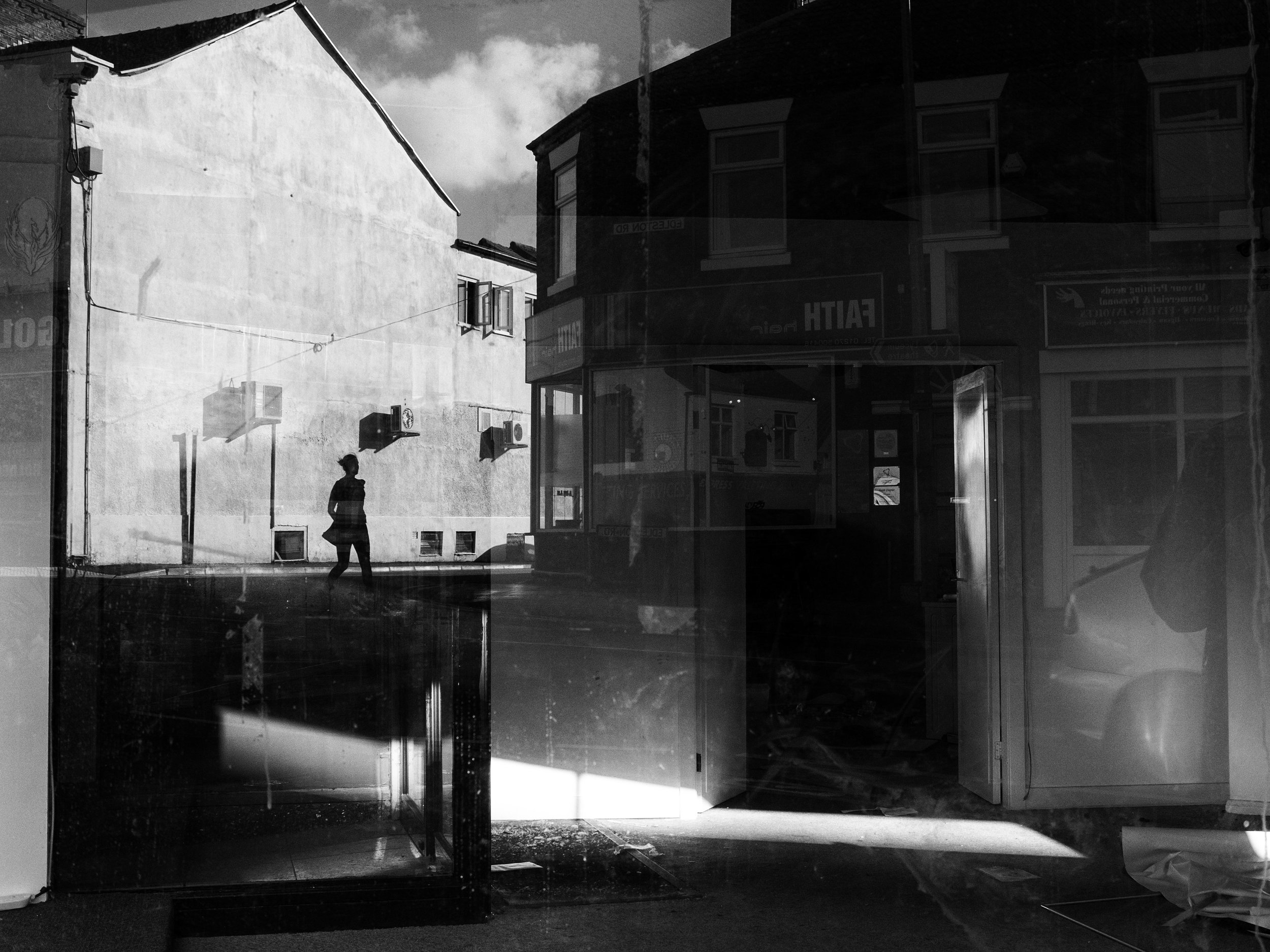Street photography in a small town
What if you enjoy street photography but you live in a small town, maybe a quiet town, where not much happens? Not all of us have ready access to busy streets full of interesting subjects to shoot. Or sometimes the streets are just very quiet and there’s nothing much happening. And what about those of us who don't live in - or near - a big bustling city with lots of activity?
Many of us live in smaller towns or even villages. Small places. Maybe places where nothing much ever seems to happen - places where everyone knows us, places where we feel really conspicuous. So what can we do? How can we make street photography work for us?
If this is the case for you, don’t give up on street photography! Through my workshops I often come across would-be street photographers who have got to the point where they feel “I don’t live in London - I live in a small town so street photography won’t work for me”. A sense of defeat takes over - a kind of inertia sets in - and it’s very easy to let that inertia take charge so eventually they don’t bother with street photography and they shoot other stuff instead. I completely accept that in a small town environment, street photography is more difficult. It’s a fact. But it’s NOT impossible and we just have to adapt and approach it differently.
But what, exactly, are the concerns? Well, I think we typically encounter two issues:
Firstly, the lack (real or perceived) of interesting subject matter. However hard you look, you can pound your high street all day and not find anything interesting to shoot. It’s just people with shopping bags, or maybe buskers, or maybe homeless people. It’s not YOU - it’s just how it is. It’s a typical small town landscape where not much is happening - let alone anything interesting. And with a lack of interesting subject matter, it’s very easy to get drawn in to shooting boring, mundane street scenes which are little more than “man crossing road with dog” - or a picture of a busker strumming a guitar - and this really doesn’t make for interesting street photography.
Secondly, there’s often a heightened sense of discomfort or unease when shooting in a small town. Attitudes are often less cosmopolitan and people with cameras stand out because it’s unusual behaviour - it’s not what people are used to seeing. Having said that, I do think we feel we stand out more - even if we actually don’t. We feel that people are watching us, thinking we look weird or suspicious or even crazy. People are pointing and laughing - or giving us dirty looks - or even getting angry. And none of us wants to be perceived in this way - although, it has to be said, you’ll find the more you do it, the less you’ll be bothered by it.
So, if these are the main issues - and I’m sure they’re not the only ones - what can we do to make street photography work for us in a small town? Actually, even if you live in a big city, I'd suggest visiting a small town or two, maybe to do a project and stretch yourself out of your comfort zone a little - you might just find you like it. So here's how you can make it work for you:
Work with what you’ve got
Firstly, we must adapt and be able to work with what’s there - we need to be realistic about what’s possible and maybe recalibrate our expectations. Or, more specifically, change our approach. Don’t expect to find Winogrand-like opportunities around every corner because you and I both know they won’t be there. So maybe shoot the sort of street images which rely on light, or form, or colour. Do something more aesthetically focused - which is frankly the sort of material you could shoot just about anywhere.
Take, for example, this great project from one of my workshop students - Neil Johansson. Neil lives in a small town called Rhyl in North Wales - a place not normally associated with great street shooting opportunities but over the past few years he's done some terrific work there, including the great image below from his project 'Within/Without’; Neil has really thought about this and has come up with a concept, which has led him into a project. So, if you live in a quiet area, embrace what it has to offer. Look for those solitary graphic figures and make your image more about the composition than about the moment or the narrative. Maybe do a project that's based more on the urban landscape than on what we traditionally think of as street photography. Embrace calmness - and simplicity.
Shoot documentary
Instead of looking to shoot what we could call classic street photography, maybe explore that really interesting space where street meets documentary. Look at some of the great work American street photographer Mark Cohen did in the small town of Wilkes-Barre in Pennsylvania - a relatively small town (certain in American terms). Cohen was born there and he produced most of his work there. Another example of a documentary project is a body of work by Jim Mortram - ‘Small Town Inertia’. And this is such a good example. Over a period of about seven years, Jim shot the his English home town of Dereham in Norfolk, embedding himself in the local community and exploring social themes such as isolation, poverty, loneliness and mental health issues. At the time of shooting this work, Jim was a full-time carer for his mother and as he was unable to escape the confines of that small town. It's a poignant and provocative body of work - and it's the sort of thing any one of us could do, we just need a good idea.
Shoot at events
Go to where people are gathering to do something specific. Visit country fairs, shows, markets, village fetes, festivals, local protests - most towns have things going on throughout the year and events can give you the focus for a project - or even just some spontaneous street shooting. And you’ll usually find there are lots of people with cameras at events so you’ll feel less conspicuous. Just as an example, I shot these at a historic motorsport day, just to document the day and not really with street photography in mind - buy you get the idea.
Get yourself known
Don’t hide - be open and confident about what you’re doing - maybe even create a little notoriety, if that’s the right word. Make a thing about being ‘the guy/girl with the camera’ and people will start to recognise you and accept you - you never know, they might even get to like you! I’ve known this happen to plenty of people and without exception they’ve actually enjoyed the attention. A good tip is to get some business cards printed. It’s a small thing, but this card in a way legitimises what you’re doing and authenticates you as a pukka photographer. It can be a great confidence booster.
Be a history maker
This is something I alluded to in my YouTube video about Joel Meyerowitz (watch it here). We would all love to be blessed with the great street scenes in 1950s Rome or 1960s New York or say Tokyo in the 80s - but we’re not. We’re shooting right here, right now, and the pictures we take are contributing to the photographic history of the world, however boring they might seem to us at this moment. There's absolutely no point in my trying to replicate the great black & white work of 50 years ago - it has to be about now; don’t try to add to a long-gone conversation - start a new one! And small or quiet towns have just as much a role to play in documenting history as do big cities - it’s just more to do with local history, and that’s fine. So accept that the time is now.
Collaborate
Join forces with others. Find like-minded street photographers and go out shooting with them. Find them through social media - or your camera club - collaborate with them on a project. Some street photographers prefer shooting alone (like me) but my sense is that most people find street shooting easier if they buddy-up with others. So start a collaborative local project. Get some publicity for it in the local paper. Speak to your local coffee bar - ask them if they will hang some of your work on that empty wall - a mini exhibition. Speak to local museums and galleries - again, you’ll find that if you start to get yourself known, you’ll find this a whole lot easier.
Be open, relaxed, friendly
Be the nice guy/girl. Be completely open about what you’re doing and don’t try to hide behind your camera. We’ve all seen street photographers who are shooting so covertly that it just looks a little weird or creepy. You could even be quite brazen about what you’re doing: if you watch Martin Parr shooting, for example, or Dougie Wallace - and they have both shot extensively in small towns - you’ll see that they’re very open about what they’re doing, really making photography normal - and it is normal! So acknowledge people, smile at them, chat about what you’re doing. Honestly, with this kind of approach you’ll have so much more of a positive and enjoyable experience.
So, wherever you live, please give street photography a chance and don’t talk yourself out of it - there are just so many street photographers who make this work for them and there’s absolutely no reason you shouldn’t too. If you were to ask me about my own approach to shooting in small towns, I tend to shoot documentary projects, for the reasons I highlighted above.
I hope you found this useful and I hope I’ve given you some good reasons to get out there and do it. Wherever you live, street photography IS an option.



